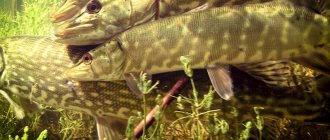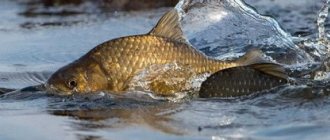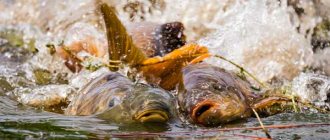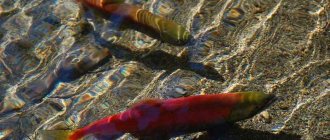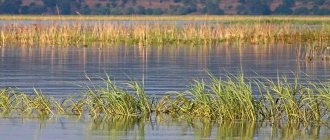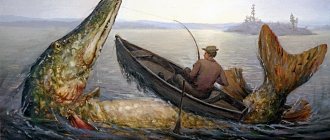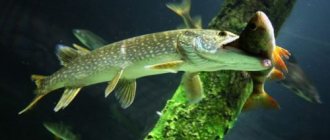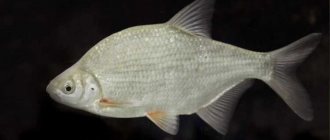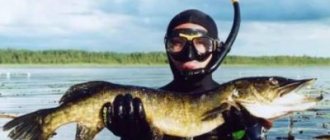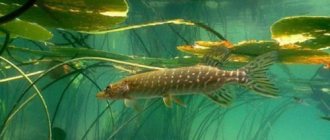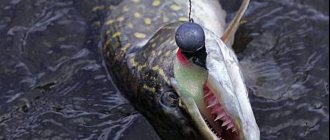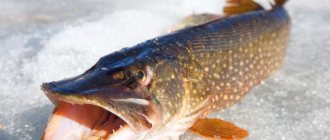For this reason, we recommend that you familiarize yourself with the peculiarities of spawning in advance. Spawning, in other words, the reproduction of underwater inhabitants, occurring during one or another favorable period for a particular species.
In the process, the female releases eggs into the water with further fertilization of the male. Each fish spawns differently depending on the temperature of the reservoir, its quality and composition. Water temperature has a greater influence on spawning. It happens that a sharp drop in temperature reduces fertilization to nothing. The spawning period is seasonal and the places are called spawning grounds among fishermen. For example, grassy shallow areas or river openings are suitable for pike.
When does pike go to spawn?
The toothy predator is often called an underwater torpedo because of the speed at which the fish moves in the water. Every fisherman wants to catch the coveted trophy. For fishing to be successful, it is worth knowing exactly when the pike will begin to spawn.
In the spring, when the sun heats the water surface to +8 degrees and melts the ice, the pike gathers to spawn. It happens that spawning begins already under the ice. Pike spawn earlier than their relatives, so by the time the rest of the inhabitants of the reservoir begin to spawn, the pike eggs will have already turned into fry, every now and then trying to swallow their prey (as a rule, these are carp). But, unfortunately, only a small part of them remain alive due to changes in water levels in the rivers. This natural phenomenon can lead pike into traps, for example, into pits.
The predator goes to spawn in early spring, usually in the last days of March or the first days of April. At first, mature pikes spawn, a little later adults take over, and at the very end the largest pikes join the spawning.
Where to look for large pike in winter
Depending on the reservoir, winter search for pike will have its own characteristics. Let's look at each case separately:
On the pond
On a pond, the predator usually does not move long distances. In order to find it, you need to at least roughly understand where the pike trails are. If the shore begins with deep cliffs, then this fish will be on or near the dumps. Often in such places there may be intertwined roots of coastal trees, where it will wait for its next victim. But in places with even depths, the pike disperses evenly throughout the pond, without concentrating in certain areas. In this regard, its search becomes noticeably more complicated, since the fisherman will have to fish considerable areas.
On the big river
On a large river, the freshwater robber tries to stay in places with less cold water. You need to look for pike where there are snags or coastal bays, but most often the toothy one is located near the lower reaches of the river. In winter, it prefers to live at depths of one to two meters, and only by the beginning of March does it move closer to the coastal zone.
About
When does pike spawning begin in central Russia?
February and early March are the time of active feeding for the predator. At this time of year, the fish tries to gain strength. Individuals are not afraid to swim to the shores, swim in the mouths of rivers, absorbing all living things on their way. Closer to the first days of April, when the ice has almost disappeared from the reservoirs and the water has warmed up to 5 - 7 degrees, it is time for pike spawning. In closed reservoirs, where the ice melts more slowly, spawning is delayed for several weeks.
In fact, everything will depend on the weather. If winter does not want to give way to spring, the fish may begin spawning under the ice. If no weather disasters are expected, pike will spawn in central Russia for a month.
How to catch pike in winter
A few recommendations for winter pike fishing.
- The fishing line should be a reliable monofilament line with a diameter of 0.24 mm. The length of the leash is 12-15 cm. If large “toothy” individuals are rare or absent in the reservoir, then a steel leash need not be used. An inactive predator can simply ignore such gear.
- For low-activity haiki, fluorocarbon leashes are used. Above the tied leash, a sliding olive sinker is placed on the main line, which will allow you to catch perfectly in a weak stream. When fishing in a strong stream, it is advisable to use an end sinker with a ring. Such tackle is capable of showing good results at different depths, from 2 to 7 meters.
- Usually, when fishing with balancers, spoons or jig baits, several holes are drilled. The holes are located in such a way that it is possible to fish all zones of the reservoir, from shallow areas to deeper areas.
- In clear sunny weather, it is advisable to darken the holes by sprinkling with a small handful of snow or position yourself so that your body can create a shadow over the drilled hole. In cloudy weather, the hole does not need to be darkened.
- In swampy bodies of water, pike should be looked for in creeks at mid-water. There is very little oxygen in such reservoirs and the fish stick to the upper layers of the reservoir. On large reservoirs or rivers, the predator, on the contrary, tends to settle in deep holes where there is a lot of aquatic vegetation and snags.
- When fishing with a spinner, the pause can be increased, since when it falls, the spinner performs interesting movements, swinging in different directions. The fall of such spinners takes much longer, unlike jig baits or balancers, so the time before the spinner touches the bottom relief increases significantly.
Pike biting in winter
If throughout the fall pike are caught all day, then with the onset of winter, the outings become much shorter and less frequent. Accordingly, the frequency of pike biting in winter decreases.
So, at the end of January and throughout February, pike outings practically stop.
With the onset of spring, when the air temperature warms up, the pike becomes active again, which many anglers take advantage of. On the last ice, the pike bite increases significantly. Now she becomes mobile, and her “appetite” returns again.
More frequent outings of the “toothy” occur from 8 to 9.30 in the morning, after which there is a short pause, and closer to 14.00 the pike bite increases again.
In what places does pike like to spawn?
For a secret ceremony, the pike chooses places that are not deep, no more than 2 meters. If you're lucky, you can see how the pike crawls with its belly along the bottom, and its back looks out of the water. Shallow bodies of water warm up faster and seem favorable for leaving offspring. The predator loves shores overgrown with reeds or reeds with a hard bottom , usually covered with branches or leaves. In search of a suitable place, the fish is able to swim considerable distances upstream, periodically looking into small rivers and bays.
The female goes to spawning accompanied by males. In such company, in search of a treasured place, the pike does not stop hunting. It is good luck for the fisherman if he meets such company on his way. The female lays eggs on the bottom, branches, and leaves. Disguise is important to her. The color allows the eggs to get lost and escape from hungry fish who are not averse to tasting the delicacy. Eggs in diameter are no more than 3 mm. In good weather they will produce excellent small pike up to 7 mm in length. At this age, fish begin to consume microorganisms, and a little later - fry. Pike development occurs quite quickly. By the age of 3 years, the individual reaches a weight of half a kilogram. At the same time, in the southern regions the fish will grow faster.
Upon completion of spawning, the individuals scatter in different directions with loud splashes. In this case, a small male can become a victim of a female if he does not think of hiding out of her sight immediately after spawning.
Fish prefer to swim to the spawning ground in the dark, but the spawning itself begins in the morning and lasts until the evening. Pike do not stand still, constantly moving around the mating site, every now and then leaving eggs on algae, stones and the bottom.
Tackle and fishing technique
In the spring, when fishing from the shore, a short spinning rod is suitable; it will be easier for them to accurately cast the bait. The best option would be a medium-fast action rod, no more than 2.5 meters long for a small river, and from 2.7 to 3.0 for a large lake, with a test weight of 10-30 grams. The reel fits 1000-2000 sizes. As the main fishing line, use thin braid from 0.08 to 0.1 mm and a steel leash 15-20 cm long.
On small lakes and rivers, the most accurate will be a side or pendulum cast, when the bait flies a short distance and trees do not interfere with the cast. If you need a medium-range cast and there are no tree branches overhead, then perform a vertical whip cast.
Retrieving should be done slowly, especially on a lake where pike are less active than on the river. Move around as much as possible, fish all promising spots, try different baits.
Do the hook immediately - short and sharp. And do it at any suspicious blow.
If the pike feels small, then you should fish it out by quickly pulling it to the shore. Larger specimens must be fished out carefully - otherwise the line may break or the upper part of the rod will break. If you come across a real trophy, then you need to use the pumping method - the fish is pulled to the shore, then the reel is reeled in until the line is tensioned and pulled in again until the fish is near the shore, where you can pick it up with your hands.
During the first zhora (before spawning), pike rushes to any artificial bait. At the same time, the predator is slow after a long winter, so it will not chase fast-swimming prey. And it will not attack large fish; it is better to use small baits. At this time, the water is often cloudy, which means there is no need to imitate forage fish; instead, you need to create a sound imitation of the fish. Wobblers and spinners are suitable for this.
Let's look at the baits in more detail.
Spoons are a classic bait for pike in the spring. Spinner baits are especially effective on warm, cloudy days. Heavy spoons are good for catching passive fish in early spring, and light spoons are suitable for shallow water. Rotating lures create strong vibration, thereby tempting even sluggish pike in cold water. They perform well at a depth of up to 1.5 meters, where the toothy fish are found. Choose the size of the turntable - No. 2-4. You need to move the lures evenly, at a slow or medium speed. Oscillating spoons on edges and drops can be guided with a step.
Wobblers are best suited for fishing in shallow water. Pike respond especially well to “Minnow” 5-8 cm long. Wobblers are carried out using a standard twitching retrieve with the addition of pauses of 2-5 seconds, and also using the “stop and go” type, when a uniform retrieve alternates with pauses of 2-3 seconds.
Jig fishing will give results when the pike stays at depth. Twisters and vibrotails should be 5-8 cm in size. The weight of the jig head is selected based on the strength of the current, usually 10-15 g is suitable. Jig baits are carried out using the usual stepped wiring. The rewinding speed should be slow or medium, with long pauses. Dragging along the bottom can also give results.
Poppers work well in May when aquatic vegetation is present.
The wiring should be of the twitching type, only the jerks will be more frequent and sharp. Pike often ambushes a couple of meters from the shore and rushes at the bait when it is practically under your feet. Therefore, wiring must be done all the way to the shore.
How many times a year does pike spawn?
Pike spawn once a year. During the process, the start and end periods of throwing may vary or shift. The life year of predators can be divided into three stages. The first and longest stage is the preparatory stage.
At this time, from mid-summer until the beginning of spring, the fish will accumulate calories, increasing their appetite. The second, short phase is spawning and the last is a two-week rest after the appearance of the offspring.
When is it better to catch pike in the fall with a spinning rod, and when with live bait?
There is no doubt that pike fishing in the fall is the most promising fishing direction. The relatively stable bite and solid catch results please fishermen who know the secrets of approaching toothy fish. One of the criteria for hunting success is the correct choice of fishing method and bait used.
In the fall, pike, still outside the withered thickets, are caught using mugs and float rods using live bait. This is due purely to the possibilities of bait supply. They catch with spinning rods, using non-snagging baits, poppers and Croatian eggs. With the decline of algae, they switch to a high-performance form of spinning fishing, using wobblers, silicone and oscillating spoons. They do not hesitate to place baits in respectable dimensions, at the same time counting on a catch that is more significant in size.
Important! After heavy and prolonged rains, they switch to fishing using live bait. The water in reservoirs becomes cloudy and it is easier for pikes to rely on their sense of smell and natural vibrations from the play of a fish attached to a hook.
What are the prohibitions when spawning pike?
The most favorable period for hunting pike is considered to be the pre-spawning and post-spawning period, when the predator experiences terrible hunger. Remember that the replenishment of the fish population will depend on this period. Therefore, after catching a pike in early spring or late winter, release the fish.
During the period of spawning, the pike becomes especially vulnerable , having lost its vigilance. The law imposed a ban on pike fishing from February to April (each region has its own rules). Being aware is important to avoid being accused of poaching. The Fisheries Department is responsible for setting fines and penalties. The fine can reach 300,000 rubles, and in addition – two weeks behind bars.
Follow the rules: do not move along the reservoir by boat, do not approach the river by car less than 200 meters.
Pike fishing during spring periods
March
In March, in most reservoirs, pike are caught from the ice. Most anglers use girders, and the most advanced ones fish with artificial baits. On rivers with strong currents in March, gullies of sufficient size already appear in which you can catch pike with a spinning rod. Good catches during the pre-spawning period are possible both when fishing from ice and when fishing in open water.
April
At the beginning of April, ice cover still remains on many reservoirs, so ice fishing gear is used. As soon as areas of open water appear, you can start fishing with a spinning rod. In stagnant bodies of water, gullies, as a rule, form near the shore, so shore fishing is the only way to catch pike.
Often success can be achieved by casting the bait onto the edge of the ice and then dragging it into the water. Such fishing can be productive, but real prospects open up when the reservoir is completely free of ice and fishing from a boat becomes possible. In April, you can get to both pre- and post-spawning zhors, which depends on the characteristics of the reservoir and weather conditions.
May
In May, the fisherman has to deal with the post-spawning glutton. Those who fish from a boat have more opportunities, but you can also fish with success from the shore, especially on rivers, since there the pike quite quickly leaves the spawning grounds and rolls into the riverbed.
Expert opinion
Knipovich Nikolai Mikhailovich
Zoologist, hydrobiologist. I am interested in fishing at a professional level.
Attention! Before you pick up a spinning rod and go hunting for pike, you need to familiarize yourself with the Rules of amateur and sport fishing in a particular region. In many regions there is a ban on pike fishing in the spring, and in some places there is even a complete ban on spinning fishing.
When does the pike bite start after spawning?
During the process of spawning, the fish does not need food, so it is useless to catch it. And after spawning, the fish will recover for several days. After starving for enough time, the fish will take up active feeding. Being exhausted, the fish will not particularly resist. Peak zhora will occur two weeks after spawning. You can hunt predators at this time using any kind of bait.
As a rule, pike fishing begins after the May holidays. As simple as it may seem, choosing the right place to hunt pike is not so easy. Individuals do not go to spawning grounds at the same time and do not begin to recover at the same time. Upon completion of spawning, pikes do not leave the spawning site, but only swim to a safe distance. At this time, the pike begins to hunt for roaches, which choose places similar to the pike for their offspring.
Large individuals live in river beds, next to gently sloping banks, in creeks or oxbow lakes. They prefer places with weak currents and shallow depths, places where the water warms up well.
Habitats where pike live
At what depth are large pike located in the cold season? Most of the winter time it does not freeze in deep areas, but moves around in search of the desired food. It often stays in places where the water temperature is higher, for example, where clearings form on the ice. In small bodies of water, this voracious fish is often found near places with a current, and in large bodies of water it often approaches the mouths of rivers flowing into the body of water. The thicker the ice cover becomes, the deeper the toothy robber goes, changing habitats.
About
Important points in fishing for autumn pike
When preparing for the pike feast in the fall, the fisherman should pay attention to some important aspects of the organization and technology of fishing. During the period of active feeding, the fish becomes less careful, which can be used by using rougher rigs, with reliable thick cords and additional clasps and carabiners for quickly changing baits. At the beginning of fishing, baits are pulled at low speeds, increasing this parameter as the bite intensity increases. If attacks are frequent, then the speed is increased, thereby achieving a quantitative increase in the catch. They try to hunt for pike using large-sized baits, thereby receiving a catch that is appropriate in size.
When does pike eat?
Throughout the calendar year, pike experience three peaks of activity, each of which has its own special nuances. Each zhor occurs strictly according to schedule and has its own name:
- pre-spawning;
- post-spawning;
- autumn.
Some anglers and authors tend to call rare bursts of predator activity in the summer, especially in August, when the pike begins to move a little compared to the lack of initiative during the thermocline, as zhor. However, this cannot be called a full-fledged zhor; rather, it is the threshold of the autumn zhor.
The behavior of pike in each of the periods of activity is unique, so further we will consider them separately, characterizing the behavior of the predator in each of the periods. In turn, the variety of natural factors introduces differences in the use of gear and bait used in pike fishing, which will also be reflected separately for each season.
Pre-spawning
The pre-spawning zhor begins in early spring after the last ice, when melt streams that enter the reservoir bring fresh oxygen, which serves as a signal for the start of activity of the inhabitants of the reservoir. The fish, starved over the long winter, gradually begin to move and feed.
The spring zhor, in addition to its focus on restoring strength, is also due to the upcoming reproductive processes, which require a large amount of energy for any fish.
Attention! It is not recommended to catch a large number of pikes during the pre-spawning feast, as this can lead to a decrease in the number of toothy predators.
The pre-spawning feast sometimes begins as early as the last ice.
It is impossible to determine exactly when the pike begins to eat in the spring; the calendar of the process may change depending on the climatic characteristics of a particular year. On some reservoirs you can successfully fish with girders on the last ice, on others the best fishing will be spinning along the thawed edges of a pond or river.
During the pre-spawning zhora, pike are caught mainly using two types of gear:
- subglacial vent;
- light spinning.
Zherlitsy
During this period, pike traps are often installed at the sites of future spawning grounds, to which predators involuntarily instinctively move during this period. These locations are wide sandbanks in the coastal zone. Sometimes only 20-30 centimeters of water remain under the ice in these places in the spring. It is here that pikes drive small fish, where they successfully eat them.
To determine the fishing horizon, fishermen use sticks with a slingshot at its lower end. They act like this:
- Lower the stick to the bottom and make a mark at the ice level.
- Raise the measurement until the rod touches the bottom edge, make a second mark.
- Measure the difference between the marks and add to it the amount of bend of the horn. This value will indicate the thickness of the free water layer.
- Add half the thickness of the water layer to the length of the stick to the second mark. This is exactly how much fishing line needs to be measured when installing the girder.
The second most important nuance of catching pike in the spring with girders is the use of narrow-bodied live bait. This is due to the fact that the belly of the fish is filled with caviar and milk, which do not allow it to swallow large prey.
Catching pike with girders using narrow-bodied live bait.
Live bait recommended for spring fishing:
- dace;
- minnows;
- roaches;
- narrow-bodied crucian carp;
- perches.
Spinning
The beginning of the appearance of edges on the reservoir is a signal to spinning anglers for the opening of the season. It is at this time that you can get to the reservoir, when the pike’s hunger is approaching its peak. For successful fishing at this time, short spinning rods up to seven feet, 210 centimeters long are used. The gradual release of reservoirs will subsequently allow the use of longer-range gear.
Bearing in mind the predator’s full bellies, they also try to use narrow baits. Most often they are caught using minnow wobblers with a small depth, sufficient for fishing in the coastal zone.
The Small River awaits its first pike fishermen in early spring.
Post-spawning
The second time of the year, the zhora begins a week or two after the spawn. During this time, the spawned pike has time to rest and complete the restructuring of its body.
The post-spawning zhor is the shortest in length, but one of the most effective in terms of catchability. A emaciated pike strives to replenish the lack of nutrients in the body as quickly as possible.
Our help! Pike do not feed during spawning, expending a colossal amount of energy!
In the short post-spawning period, it is best to catch pike using a spinning rod, although many amateurs also use a float bait fishing rod. However, the beginning of the season is not very productive in terms of live bait due to the fact that most of the fish species just begin to spawn at this time, and catching the required number of fry can be problematic.
At this time, spinning rods are used to catch a wide variety of baits. In the first days, the zhora try to catch former spawning grounds, gradually moving to deeper places in the reservoir.
The choice of bait is also subject to this movement. First use surface baits:
- wobblers;
- spinners;
- light vibrations.
Then they gradually switch to fishing in deep places:
- jig baits;
- heavy spoons;
- deep-sea wobblers.
Advice! During this period, you can also use wide-bodied baits with active action: crankbaits, rattlins and jerkbaits.
The pike took a jerkbait - an exact copy of a crucian carp.
Autumn zhor
The longest period of time is the autumn feeding period for pike. It begins in September and continues until the freeze-up. At this time, the pike is preparing for a long winter and trying to stock up on a large amount of nutrients.
Installation of a diverter leash for pike fishing
With the onset of autumn, the natural conditions on the reservoir change:
- the water cools and clears;
- aquatic vegetation dies off;
- potential prey scatters throughout the body of water.
These factors force the pike to leave their usual ambush places for summer stops and begin to move around the reservoir in search of food, and they often gather in small schools for driven hunting for schools of small fish.
To catch pike during the autumn zhora, various tackles are used:
- float baits;
- mugs;
- spinning in different directions, including trolling.
